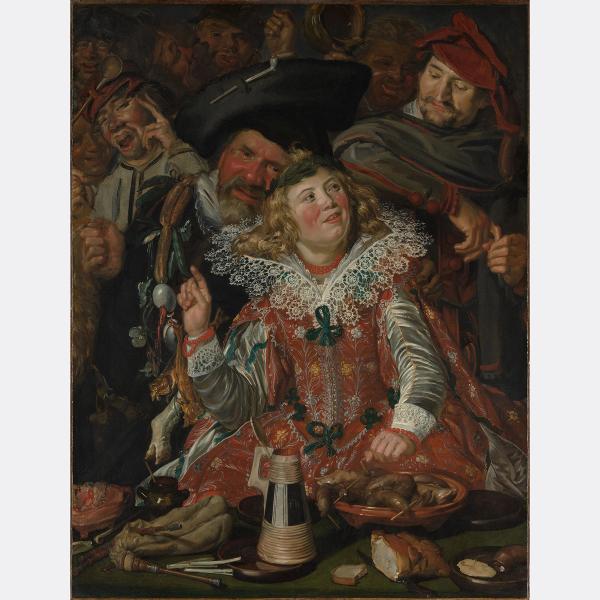Merrymakers at Shrovetide
Artwork Details
- Title: Merrymakers at Shrovetide
- Artist: Frans Hals (Dutch, Antwerp 1582/83–1666 Haarlem)
- Date: ca. 1616–17
- Medium: Oil on canvas
- Dimensions: 51 3/4 x 39 1/4 in. (131.4 x 99.7 cm)
- Classification: Paintings
- Credit Line: Bequest of Benjamin Altman, 1913
- Object Number: 14.40.605
- Curatorial Department: European Paintings
Audio

5031. Merrymakers at Shrovetide
Frans Hals, 1616-17
LINDA CIVITELLO: This painting is dripping with carnality of all kinds, of food, appetite, sexual appetites…
My name is Linda Civitello. I'm a food historian.
NARRATOR: There seems to be food everywhere in this painting—on the table in front, and draped over the shoulder of the man at left—and all of it had very specific connotations at the time.
LINDA CIVITELLO: From sausages to pig’s feet to herring, mussels, all of these represent male and female genitalia. There is a man in the background making a sexual gesture with his hand. There's an open pot in the foreground with a stick in it. So again, very sexual.
NARRATOR: Associate Curator Adam Eaker.
ADAM EAKER: This painting commemorates the festivities that would have been celebrated in a Dutch town at Shrovetide, which is the original English name for what is now more familiar as Mardi Gras. It’s the last hurrah, the last bout of excess before Lent begins.
LINDA CIVITELLO: So they would celebrate with all of the things that you were not supposed to eat during Lent: meat, fish, eggs. And herring and bread and ale, all of which are on the table, were the three foods that cut across class, gender, cut across everything. Herring, ale, bread, all classes ate that.
NARRATOR: At the time Frans Hals painted this, the Dutch were fighting for independence from Spain.
ADAM EAKER: And very much embraced what we might think of as some of the cruder aspects of humor as a way to distinguish themselves from the very prim and austere court culture of the Spanish. So, there’s a sense in which Hals is reveling in earthiness, in coarse humor.
One thing I love in this painting is the way that Frans Hals signed it. So right in the foreground, is this tankard of ale with its lid raised. And you’ll notice that incised on the side of the tankard are the initials F.H. So on the one hand, he’s making sure we don’t overlook his signature and on the other, he’s playing a kind of joke, very much associating himself with the kind of drunken revelry that you see unfolding in the picture.
More Artwork
Research Resources
The Met provides unparalleled resources for research and welcomes an international community of students and scholars. The Met's Open Access API is where creators and researchers can connect to the The Met collection. Open Access data and public domain images are available for unrestricted commercial and noncommercial use without permission or fee.
To request images under copyright and other restrictions, please use this Image Request form.
Feedback
We continue to research and examine historical and cultural context for objects in The Met collection. If you have comments or questions about this object record, please contact us using the form below. The Museum looks forward to receiving your comments.
